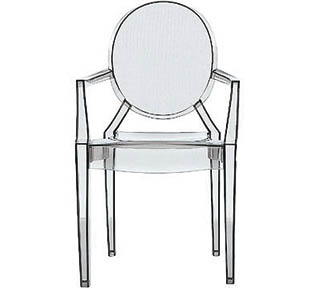

|
Clear thinking
Using glass and acrylic in decor
helps make the typical isle home
seem bigger
Adding glass to interior decor is like having a magician perform in your home. The natural material is a barrier you can see through; it can cut a room in half, yet the area still appears whole; objects placed upon it seem to float; and it can even make one see double.
But don't be fooled by the illusion. If it looks like glass, is transparent and reflective like glass, it could well be the likes of Lucite. And if so, whatever you do, don't call it Lucite or, worse, plastic.
"If you say Lucite, you're dating yourself," designer Liz Teruya said.
And if you call it plastic, salespeople will glare at you. (The word plastic somehow doesn't quite have clout.)
Whether acrylic, Lucite or glass, clear thinking in accessories can do wonders for the home. Casting shimmers of light, coffee table tops, lamps and vases made of these substances give the home an ethereal quality and add a layer of texture to its design landscape.
"It's a good balance when you go from upholstery to wood to walls -- with all the solid surfaces. Glass (or acrylic) is a nice translucent contrast in texture," said Amy Pritikin, a design consultant at C.S. Wo Gallery.
It might be tough to find acrylic in any of the usual places one would buy furniture here, however.
"In Hawaii we're a little behind," said Pritikin, who has also worked in Beverly Hills, Calif. "We don't get (trends) as soon as they hit New York or Europe."
Some trends never even make it to Hawaii since manufacturers also determine what's readily available on the market. "The buying public is, in a way, swayed by what the manufacturers produce for them to purchase. If it's not feasible for the manufacture to do acrylic (or companies to bring it in), it would be hard to find."

|
Yet, acrylic accessories such as lamps and waterfall-style tables are often featured in home-design catalogs and on popular mail-order Web sites such as CB2 (www.cb2.com) and Conran (www.conran.com/home), currently the best bet for those here looking for such accessories.
Either that, or seek the services of a designer.
"Lucite is everywhere," said Teruya, an interior designer for Next Design, naming those on the cutting edge of its resurgence such as Knoll with its version called Imago, and another called Lumicore. "But Hawaii people tend to be more traditional, so they'll go with the obvious, like glass" when it comes to clear accessories.
"Hawaii people are more cautious and are less likely to think outside the box, which is what designers do."
Plastics such as Lucite and Plexiglas were developed in the 1930s. Lucite was a low-density, crystal-clear material made by DuPont. It was impervious to water and UV rays and stronger than previously developed plastics. The Rohm & Haas Chemical Co. called its version Plexiglas. The product was the company's primary focus, so it sold at competitive prices and therefore did better than Lucite, now owned by another company. Both were used in supplies during World War II, and afterward, to make jewelry and such. Lucite rings, handbags and lamps were popular in the '50s and '60s. It had its heyday in the mid-'70s when people desired strong and clear, modern space-age items but stayed away from glass because it's fragile and not as easy to bend and mold.
The style went the way of lime green shag rugs, but retro is in and acrylic is making a comeback, said Pritikin. "Interior design is like fashion, and we're always looking to do something other than what we've been doing."

|
Today's acrylics are so versatile, said Teruya. "You can do wonderful things with them. It can be tinted; other things (such as fabric and bamboo reeds) can be sandwiched in between; it can be carved." Teruya, who is juggling a budding design firm of her own called E Designs, has used acrylic panels as art pieces, functioning as walls that are backlit for a three-dimensional effect.
"It's used mostly in commercial applications but also in homes, more for people who are in high-end residential homes because it can get costly.
There is, however, nothing like glass, said Teruya. "It's simple elegance. Acrylic doesn't have the ability to have such brilliance. Glass is beautiful in that way."

|
Pritikin, too, prefers glass for its ease in care. "You can just Windex it." Acrylic has a tendency to scratch, and it's difficult to repair, she added.
She offers the following tips for incorporating glass or glasslike objects into the home:
» Mirrors are wonderful, reflecting light, pushing walls back. They can also reflect a beautiful view, whether ocean or mountain, and become the extension of your focal point, which might be nature."The typical home in Hawaii isn't huge," said Pritikin. "Glass or acrylic, when used correctly, can make a room seem larger. It doesn't block space and reflects light, giving the room a more airy feel."» Clear lamps are great when used in contrast to wood or marble tables, but by the same token it's interesting to put glass lamps on glass tables for a nice blending.
» Clear vases can be especially intriguing, depending on what flowers are placed in them. Adding river rocks or pebbles to the water creates texture, complementing the flowers but not competing with their beauty.

|

Click for online
calendars and events.